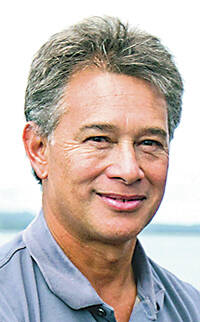Drought conditions are becoming “a crisis” in some areas of Hawaii Island.
Tina Stall, a National Weather Service hydrologist in Honolulu, said the driest areas are in the Ka‘u and Hamakua districts, as well as the leeward lower elevations of Kohala.
“It’s really a lot of the same,” said Stall, comparing July’s rainfall and the first week of August to June. “There’s not much improvement for most areas, and the Hamakua and Ka‘u areas are still in pretty bad shape.”
Hilo International Airport, with 3.75 inches of rain, and Waiakea Experimental Station, with 4.7 inches, had their driest July since 2010, while Hakalau, at 1.26 inches, experienced its driest July since 2011.
Kealakomo, at 0.4 inches, had its second-driest July on record, as did Waimea, at 1.4 inches.
Conditions on the island range from abnormally dry to extreme drought, and the absence of rain has left many areas quite dry and prone to wildfires.
The Big Island has had several red flag warning days in the past month, the same conditions where abnormally arid and windy conditions lead to increased fire hazards.
Those were the conditions in effect when Maui had the catastrophic fires two years ago that left more than 100 people dead. West Hawaii had wind-driven wildfires, as well, without the loss of life, but with seven structures destroyed or damaged.
A brush fire on parched pastureland near Paauilo on Thursday blackened about 150 acres, requiring both county helicopters to make water drops and bulldozers to cut fire breaks. Another brush fire was reported in the area mid-afternoon Friday, causing a road closure on Highway 19 between the 36 and 39 mile markers and advisories to residents near Old Mill Road in Paauilo to be prepared for evacuation.
On Saturday, there was a small fire near the 21-mile marker of Highway 19 on the Hamakua Coast that led to the temporary closure of the Hilo-bound lane.
A nearby rain gauge in Honokaa received just 2.28 inches for July, 31% of its usual total for the month, and 19.38 inches for the first seven months of the year, 32% of average.
“We’re about halfway through the dry season, so we’ve got a ways to go yet,” said Talmadge Magno, Hawaii County Civil Defense administrator. “We knew we were going to have an issue coming out of the wet season this past winter, because rainfall was below average already.”
“I was talking … to the National Weather Service (on Thursday), and we’re probably about 50% under what we’re supposed to have,” Magno continued. “It’s contributing to fires, and you have some folks on catchment, so we’re monitoring that to make sure the Department of Water Supply has enough spigots out for folks, enough for the water haulers so they can provide for the folks who are on catchment.
“We’re also encouraging people to order water early, before they run out, basically.”
State Sen. Tim Richards of Waimea, a large-animal veterinarian who grew up on Kahua Ranch, said the drought in some areas — including Waimea, Kohala and Hamakua — “is absolutely a crisis.”
“Because of our tropical grasses, most of our livestock get almost half of their water through grazing,” Richards said. “But when it’s really dry, the demand for water almost doubles because the livestock gets water from the grass itself. And that’s where it really strains our watering system.
“The water systems are being put to the test. The Hamakua ranchers are running out of stock water. We just got permission to tap into the Waimea water system that (the state Department of Agriculture) runs to allow us to pull water for emergency services for livestock. We’re short of feed right now, but more pressing than that is the shortage of drinking water.
“And of course, the crops, everything that relies upon rain, everything’s being impacted by that.”
Email John Burnett at jburnett@hawaiitribune-herald.com.
